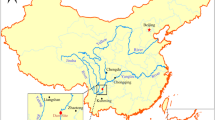Conclusions
-
1.
At present there are no grounds to expect reaching a limit state for the powerhouse of the Kama hydrostation in the near future.
-
2.
The small effectiveness of the grout curtain is noted. Grouting works should continue.
-
3.
Serious hydrogeological investigations are needed for explaining the cause of the anomalously low heads of ground-waters on the right bank (lower than the lower pool).
-
4.
The correctness of the decision about disconnecting the vertical drainage is confirmed. Its operation increases water exchange between horizons and can accelerate dissolution of gypsum.
Similar content being viewed by others
Literature cited
L. Lukner and V. M. Shestakov, Modeling of Groundwater Flow [in Russian], Nedra, Moscow (1976).
G. K. Mamenko, “The Kama dam on the Kama River,” in: Geology and Dams [in Russian], Vol. 5, Énergiya, Moscow, (1967).
Additional information
Translated from Gidrotekhnicheskoe Stroitel'stvo, No. 7, pp. 39–42, July, 1990.
Rights and permissions
About this article
Cite this article
Shestopal, A.O., Sinyavskaya, A.A. & Kushlin, V.V. Investigation of the seepage regime in the foundation of the kama hydroelectric station on a three-dimensional model. Hydrotechnical Construction 24, 475–479 (1990). https://doi.org/10.1007/BF01435429
Issue Date:
DOI: https://doi.org/10.1007/BF01435429




